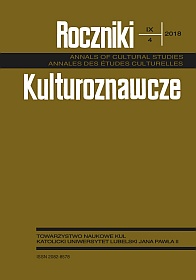Reflection on Virtual Cemeteries: Social and Cultural Conditions
Abstract
Virtual cemeteries, even though existing marginally within funereal rituals, appear regularly in cyberspace and have their audience. The number of places of worship and the virtual funereal services is increasing.
This paper answer the questions whether virtual cemeteries are inescapable social practice connected with death and grief ritual, whether they become a part of this ritual and if they allow the experience of the bereavement.
Social conditions, like changes within funereal rituals, mediatization, internet popularizing, moving to the cyberspace social practices, deepening privatization and rituals’ individualization, and also cultural conditions, like shaping individual meanings and context of the culture and culture pauperization, are laying the foundations of virtual cemeteries. One criticizes them for changing the traditional late cult and the memory rituals, others value them for giving the opportunity of the visualization of their relatives’ graves and creating a new space, where the cult of late can be celebrated.
References
Af Segerstad, Ylva Hård, i Dick Kasperowski. „A community for grieving: affordances of social media for support of bereaved parents”. New Review of Hypermedia and Multimedia 21 (2014), nr 1–2: 25-41.
Alev Dilmac, Julie. „The New Forms of Mourning: Loss and Exhibition of the Death on the Internet”, OMEGA — Journal of Death and Dying 77 (2016), nr 3: 280–295.
Ariès, Philippe. Człowiek i śmierć. Przełożyła Eligia Bąkowska. Warszawa: Państwowy Instytut Wydawniczy, 1992.
Brubaker, Jed R., Gillian R. Hayes i Paul Dourish. „Beyond the Grave: Facebook as a site for the expansion of death and mourning”. The Information Society 29 (2013), nr 3: 152–163.
Carroll, Brian, i Katie Landry. „Logging On and Letting Out: Using Online Social Networks to Grieve and to Mourn”. Bulletin of Science, Technology & Society 2010, nr 30 (5): 341–349.
Church, Scott H. „Digital Gravescapes: Digital Memorializing on Facebook”. The Information Society 2013, nr 29: 184–189.
Cyrek, Barbara. „Kultura funeralna w cyberprzestrzeni. Co łączy wirtualne cmentarze i me¬dia społecznościowe?”. Kognitywistka i Media w Edukacji 2017, nr 2: 92–100.
Falconer, Kimberly, Mieke Sachsenweger, Kerry Gibson, Helen Norman, „Grieving in the Internet Age”, New Zealand Journal of Psychology 40 (2011), nr 3: 79–88.
Gierwazik, Małgorzta, i Krzysztof Martyniak, „(Nie)prawdziwi żałobnicy. Wirtualne cmentarze”. Studia Informatica 2011, nr 28: 232–238.
Gonczaronek, Hiacynta, i Ewa Kubasik, „Pochówek na przestrzeni wieków w kulturze europejskiej”. W: Elżbieta Krajewska-Kułak, Cecylia R. Łukaszuk, Jolanta Lewko i Wojciech Kułak (red.). W drodze do brzegu życia. T. XII, 235–244. Białystok: Uniwersytet Medyczny w Białymstoku, Wydział Nauk o Zdrowiu, 2014.
Harju, Anu A. „Socially Shared Mourning: Construction and Consumption of Collective Memory”, New Review of Hypermedia and Multimedia 21 (2015), nr 1–2: 123–145.
Ilczuk, Dorota, i Kazimierz Krzysztofek, Znaczenie kompetencji kulturowych dla budowanie kreatywności i kapitału intelektualnego Europy. Ekspertyza na Zlecenie Ministerstwa Kultury i Dziedzictwa Narodowego Wersja 1.0. Warszawa: Narodowe Centrum Kultury, 2011.
Janiak, Agnieszka. „Nowe funkcje kulturowe wirtualnych nekropolii”, w: Agnieszka Dyt¬man- Stasieńko i Jan Stasieńko (red.), WWW w sieci metafor: strona internetowa jako przed¬miot badań naukowych, 421–429. Wrocław: Wydawnictwo Naukowe Dolnośląskiej Szkoły Wyższej, 2008.
Jiang, Jialun, i Jed R. Brubaker, „Tending Unmarked Graves: Classification of Post-mortem Content on Social Media”, Human-Computer Interaction 2 (2018), nr CSCW art. nr 81: 1–19.
Kamińska, Magdalena. „‘[ ` ] [ ` ] [ ` ] :((( :*…’ Praktyki żałobne w cyberprzestrzeni”. Kultura Popularna 2012, nr 3: 110-120.
Kern, Rebecca, Abbe E. Forman i Gisela Gil-Egui, „R.I.P.: Remain in perpetuity. Facebook memorial pages”, Telematics and Informatics 2013, nr 30: 2–10.
Kolbuszewski, Jacek. Cmentarze. Wrocław: Wydawnictwo Dolnośląskie, 1996.
Krzysztofek, Kazimierz. „Zdekodowane kody”. W: Anna Maj i Michał Derda-Nowa¬kowski (red.). Kody McLuhana. Topografia nowych mediów, 12–29. Katowice: Wydawnictwo Naukowe ExMachina, 2009.
Lagerkvist, Amanda. „New Memory Cultures and Death: Existential Security in the Digital Memory Ecology”. Thanatos 2 (2013), nr 2: 8–24.
Levitt, Laura. „Posting Grief on the Wall Using Facebook to Grieve and Offer Support After a Tragedy”. The Elon Journal of Undergraduate Research in Communications 3 (2012), nr 1: 78–86.
McNair, Brian. Seks, demokratyzacja pożądania i media, czyli kultura obnażania. Przełożyła Ewa Klekot. Warszawa: Wydawnictwo Muza, 2004.
Meese, James, Martin Gibbs, Marcus Carter, Michael Arnold, Bjorn Nansen, Tamara Kohn. „Selfies at Funerals: Mourning and Presencing on Social Media Platforms”. International Journal of Communication 2015, nr 9: 1818–1831.
Miejsca Pamięci, dostęp 15-11-2018, Serwis, http://miejscapamieci.pl/index.php?p=serwis.
Nager, Elizabeth A. i Brian de Vries. „Memorializing on the world wide web: patterns of grief and attachment in adult daughters of deceased mothers”, OMEGA — Journal of Death and Dying 49 (2004), nr 1: 43–56.
Anna Pietrzyk. „Śmierć w Internecie. Internet jako teren badań i źródło wiedzy etnograficznej”. W: Ewa Jagiełło i Paweł Schmidt (red.). Homo interneticus: etnograficzne wędrówki w głąb sieci, 88-97. Lublin: Wydawnictwo Portalu Wiedza i Edukacja, 2010.
Refslund Christensen, Dorthe, i Stine Gotved, „Online memorial culture: an introduction”, New Review of Hypermedia and Multimedia 21 (2015), nr 1–2: 1–9.
Roberts, Pamela. „From Myspace to our space: The functions of web memorials in bereavement”. The Forum 2006, nr 32(4): 1–4.
Roberts, Pamela. „Here today and cyberspace tomorrow: Memorials and bereavement support on the web”. Generations 2004, nr 28 (2): 41-46.
Sumiala, Johanna, i Outi Hakola, „Introduction: Media and Death”, Thanatos 2 (2013), nr 2: 1–5.
Ulguim, Priscilla. „Digital Remains Made Public: Sharing the Dead Online and our Future Digital Mortuary Landscape”, Online Journal in Public Archaeology 3 (2018): 153-176.
Wagner, Anna J.M. „Do not Click ‘Like’ When Somebody has Died: The Role of Norms for Mourning Practices in Social Media”. Social Media + Society 4 (2018), nr 1: 1–11.
Wirtualny cmentarz, Informacje o serwisie, dostęp 6.11.2014, http://www.wirtualnycmentarz.pl/html_core/tekst/informacja_o_serwisie.html.
Wojnar, Anna. „Współczesne ujęcie kultury”. Alma Mater 2008, nr 100.





